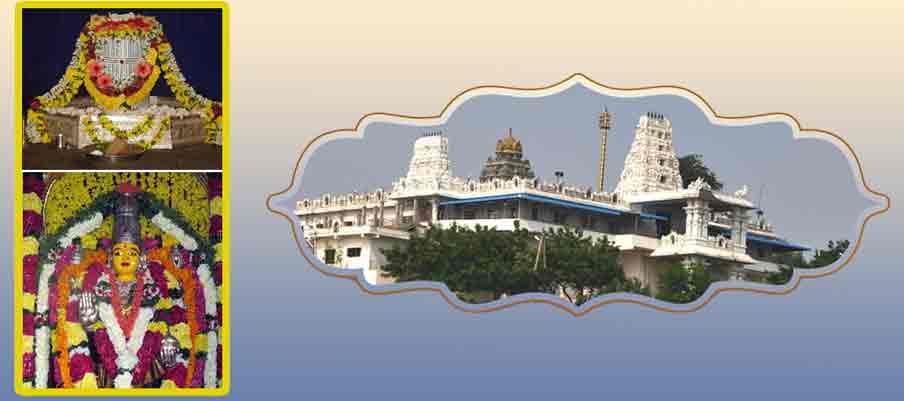
Sri Ramalingeswara Swamy Temple
Temple History
According to Vaastu Shastra, temples surrounded by natural elements like greenery, water bodies, hills, and flowing rivers are believed to possess immense spiritual power and significance. Such temples are considered ideal for worship and attract devotees who firmly believe their prayers and vows are fulfilled here.
Sri Ramalingeswara Swamy Temple is located on a 612-foot hill in Yanamalakuduru near Vijayawada. The stunning view of the River Krishna and the surrounding landscape enhances the sacred aura of this temple. At night, the illuminated shrine stands out in the skyline and can be viewed from various parts of the city and along the river.
The main deity, Lord Ramalingeswara, is worshipped in the form of a self-manifested (Swayambhu) Vayu-Linga, believed to have been consecrated by Sage Parasurama. It is one of the ancient temples established along the Krishna riverbanks during the divine journey of Parasurama, who sought to perform penance and restore peace after the destruction of the ruling warrior clans.
Legends of Sage Parasurama
In the Parasurama incarnation, Lord Vishnu took birth as a Brahmin to end the oppression caused by arrogant Kshatriya rulers. As the son of Sage Jamadagni and Renuka, Parasurama wielded an axe bestowed upon him by Lord Shiva. After his father was killed by the sons of King Kartavirya, Parasurama avenged his father by defeating the Kshatriyas in 21 battles. To atone for the destruction, he established Shiva Lingas across sacred locations, including this Vayu-Linga at Yanamalakuduru.
The site was once known as Munigiri, meaning "Abode of Thousand Sages." Parasurama is believed to have protected these sages from demon forces and installed the sacred Linga that continues to be worshipped here.
Significance of the Deity
The Shiva Lingam at this temple is placed on an eight-faced pedestal (Ashta Mukha Panapattam). A unique feature is that, during sunrise, sunlight directly falls on the Linga, symbolizing a divine offering of worship by the Sun God. Special rituals and decorations are performed every Monday and on festive occasions.
It is also believed that Lord Sri Rama and Goddess Sita visited this place during their exile and offered prayers to Lord Shiva here. The deity then came to be worshipped as Lord Ramalingeswara.
Serpent Legends
According to temple beliefs, celestial serpent maidens called Nagakanyas are said to worship the deity at night. An anthill located about 100 feet from the temple's main sanctum is associated with Nagendra. Devotees believe there is a hidden path connecting the anthill to the sanctum, through which the serpent deity offers daily worship. Priests allow time in the morning for the serpent to leave before beginning temple rituals.
Historical records suggest that the temple was worshipped by rulers from dynasties like the Kakatiyas, Vijayanagara Empire, Chalukyas, and the Reddy Kings.
Temple Rituals and Renovations
The temple witnesses a massive influx of devotees during Maha Shivaratri, particularly for the Prabha Mahotsavam festival, where decorated chariots are pulled through the village streets as part of a vibrant folk celebration.
In 1983, the temple was renovated under the leadership of Sri Dhanekula Sivannarayana Garu, and the consecration ceremony was performed by Sri Bharathi Tirtha Swamy. Support from devotees led to further expansion and the construction of additional shrines within the complex.
The temple now features sub-shrines dedicated to Sri Maha Ganapathi, Sri Subrahmanyeswara Swamy with Srivalli and Devasena, and a majestic Hanuman statue outside the main complex. A Rajagopuram marks the entrance to the expanded footpath for pilgrims climbing the hill.
A Yagna Mandapam was also added for conducting Vedic rituals, and in 2013, the sacred Nagendra Swamy anthill was restored and reconsecrated.
Temple Festivals
Mahasivaratri Brahmotsavams: Celebrated in the month of Magha (February/March), this festival includes Prabhotsavam, Gramotsavam, Kalyanotsavam, and Dhwajarohana. During Dhwajarohana, rice balls called Nandi Muddalu are tossed into the air, and childless devotees try to catch them for blessings. Lighting of Akhanda Deepams during Shivaratri is also considered auspicious.
Masa Sivaratri: On monthly Shivaratri days, special rituals are performed along with Annadanam (food offering).
Sravana Masotsavams: Held during the month of Sravana (August–September), with special pujas dedicated to Goddess Parvati.
Dasara Celebrations: This nine-day festival, observed during Navaratri, includes rituals, Navadurga alankarams, and vahana sevas.
Kartheeka Masotsavams: Celebrated in the month of Karthika with the lighting of lamps throughout the temple. The Kumbhabhishekam ritual is performed on Arudra Nakshatram during this month.
Temple TimingsMorning: 6:00 AM to 12:00 PM
Evening: 5:00 PM to 8:00 PM
